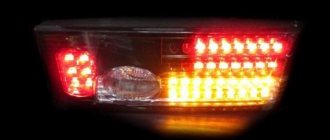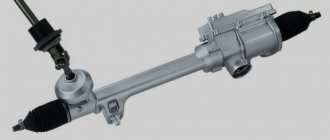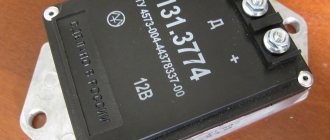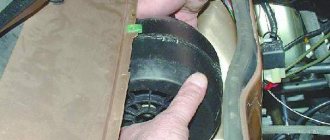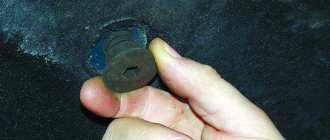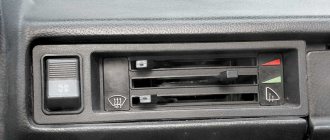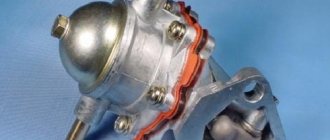AutoGourmand
Nowadays, few people will believe that 20-30 years ago, not a single car plant produced convertibles. Apparently there was no demand. And it didn’t exist precisely because no one bothered to organize the production of convertibles in our country.
“Good” guys from the auto industry reasoned like this: “We are a northern country, what other convertibles are there!” The main thing is that the stoves work reliably.” That's how we were left without open cars. True, without reliable stoves too. Then another thesis was put forward: “When producing a mass car for the mass consumer, there is no time for frills. The main thing is more and simpler.” However, this argument did not work either. And it was the mass consumer who was the first to rebel against such argumentation. Alas, not with us.
In the then West Germany, our “Samara” enjoyed considerable success due to that very simplicity and how much this simplicity cost. But over time, the burghers began to get tired of cars that were identical not only in their simplicity of design, but also in their simplicity of external design. They wanted to get a car to their liking. And the Germans have very specific taste - they really like convertibles. Owners of “Samar” increasingly yearned for communication with nature without leaving the steering wheel.
Actually, the first open versions of the VAZ-2108 were closer not to convertibles, but to landaulets. In any case, the roof over the front seats was retained, although reduced to a minimum due to the hatch. Instead of a tailgate cut off together with the rear door, a plastic “trough” was attached to the body, which served both as a trunk and a niche for laying a synthetic awning with soft side and rear windows. The folded awning also occupied part of the space behind the back of the rear seat, so the comfort in the new “eight” was reduced. But, despite everything, it was still a convertible, and even with a touch of exoticism. Received the designation Lada Samara Fun, it appealed to those who passionately wanted to drive an open car, but could not afford to buy one.
The example of the Germans turned out to be contagious, and a year later, with the active assistance of JSC Scaldia Volga, which sold Soviet cars in Belgium, another version of the convertible based on the VAZ-2108 was born. Actually, this was also a version of the landau, but with a more elegant body and a modified manual roof laying system. The same “trough” becomes more elegant, a separate trunk appears, and the space behind the back of the rear seat is used more efficiently.
When folded, the roof awning was covered with a special cover. As a result, the level of comfort did not change, and the cost of modifying the body was significantly lower than that of the Germans. The new model was named Natasha and became the ancestor of all subsequent convertibles based on the Samara. In Brussels, and later in Bratislava and Prague, small production facilities are opened, where new cars are produced in small batches.
The bulk of them are exported to France and Spain, where these machines enjoyed great success for 5 years. At the 1996 Barcelona Salon, the head of the Spanish branch of Lada Internacional, Julio Garcia Martinez, expressed regret about the cessation of supplies of the Natasha version to Spain. Meanwhile, no one stopped assembling the convertibles so beloved by the Spaniards. It’s just that they all began to go to Russia, where they also gained many fans. At one time there was even talk about the deployment of a kind of multinational production “Cabrio-Samar” with the participation of Germans, French, Belgians and Czechs. But soon the project died, and for reasons far from technical or economic.
Meanwhile, in the Czech Republic itself, from the “pen” of the outstanding designer Vaclav Kral, another version of the open “eight” comes out. As the maestro said, he became interested in what could be made from a Togliatti small car. After a year of research and development, he creates the Bohemia convertible and in 1993 shows it at a personal exhibition in Prague. According to Vaclav, a certain group of influential representatives of the Czech auto business is buying the prototype, documentation and the right to manufacture the car from him. For 5 whole years, the convertible disappears from the creator’s sight. And suddenly, in 1998, the Czech company CS Auto-Lada announced the start of production of Bohemia. Moreover, it is even planned to organize a demonstration of the new product in a showroom on Koneva Street in Prague. (A distinctive feature of Bogemia is the Targa roof and significantly modified body sides.) According to Bohumil Spevak, director of marketing and sales, the company has already formed a portfolio of orders for Bohemia.
But perhaps the most original and spectacular convertible project appears on the other side of the Atlantic. JSC Lada of Canada begins small-scale production of a “real” full convertible based on the VAZ-2108 with mechanical folding and installation of a roof. First of all, Canadians cut the “Gordian knot” of the rear body and trunk lid: they use the rear side panels and trunk lid from the VAZ-21099 model. The design of the doors is completely changed.
Reinforcing elements of rigidity appear behind the back of the rear seat. As a result, a car is born that is not very difficult to modify, with a complete original design and excellent body lines.
It is possible not only to maintain all dimensions of the interior, but also to significantly improve comfort by installing new seats. The new product easily passes all certification tests according to North American standards. The Canadian version can undoubtedly be considered the best of all attempts to make a convertible based on the VAZ-2108.
In Russia itself, it suddenly turns out that convertibles can be made “from just about anything.” At several Moscow motor shows and “Autoexotica” car parties, an open version of the GAZ-24 “Volga” is demonstrated. The involvement of our military in the birth of this convertible is immediately apparent - it is revealed by the traditional “ceremonial” body color. It should be noted that the body of this car and the richly trimmed interior look much better and more modern than its standard counterparts.
Further more. Excellent convertibles can also be made from Niva. There are rumors that “Avto-Moskvich” is also preparing something. Maybe the traditionally elegant brainchild of Moscow designers will be called “Vasilisa the Immortal,” who knows.
And just recently news came from Naberezhnye Chelny - they managed to make a convertible from the Oka. Agree, it’s not so easy to make an elegant “ceremonial horse” out of such a baby, and even one that would please such a picky customer. But this is already something from the realm of wonderful creations of the Tula Lefty.
Over the past 10 years, more than a dozen different versions of convertibles based on Russian-made production cars have been born. And they all found their adherents and buyers. I wonder what those same dignitaries from that same auto industry think about this? What brand of convertibles do their children and their households drive around in?
1992 LADA 2108 convertible
VIN or body number: XTA21081*M0****79 Engine power: 69 hp. Owners according to title: 2 Condition: not damaged Engine capacity: 1.5
Export car from Germany. Semi convertible. Sale on stamps. Call to confirm.
Price: 60,000
avito.ru
Email
A little history
There was demand for the G8, but dealers and importers decided to improve the car. This is how studios appeared, whose specialists modified cars to meet customer requests. Some ordered sports body kits, alloy wheels and imported tires, others wanted sports seats, an improved steering wheel, a sunroof, and a modern audio system in their car. But all this was insignificant compared to the development of an exotic modification based on the G8 with a semi-open landau body. After which the VAZ-2108 (convertible) was released.
The first open-top version was built by a Belgian little-known in 1988. The car was developed in a single copy for a local exhibition, but the idea was quickly picked up by representatives of the largest importer of Soviet cars, which was the company JSC Scaldia-Volga.
They began to design a “driving” production convertible. Specialists from Garage Meeus, which is the oldest Belgian coachbuilder, took on a significant redesign of the hatchback design. The look was finalized by Vladimir Yartsev, a designer from Tolyatti AvtoVAZ. The work was painstaking, but already in 1990 a public display of the exotic new product took place in Brussels.
Exploitation
Now it’s worth paying attention to the reviews left by people who have a VAZ-2108 car in their garage. A convertible, of course, is a rarity on our roads, because models in this body were produced in other countries. However, Soviet enterprising car enthusiasts who picked up the idea and deprived the G8 of the top on their own often share their impressions.
People say that this is a good car, but it requires constant attention. Especially the engine and chassis. The owners joke that they don’t have to pay any attention to the body at all – it will rust anyway. But it is advisable to install a short-throw rocker, otherwise it will be difficult to engage third gear. And it is advisable to invest in expensive pads to improve braking performance. People consider cheap spare parts, high maintainability and a reliable engine to be its advantages.
What else is worth knowing?
The Eight is an indestructible workhorse. Even if it is made in a convertible body. The Soviet design is indeed very durable, and the cost of restoration of the main components is minimal when compared with the cost of the same work in the case of foreign cars.
But the body suffers from intensive use. Many people complain that the number of enamel chips is increasing every year. Therefore, regular priming and touch-up cannot be avoided.
However, technically this car is not bad. You can drive it long distances and be sure that it won’t break down in the middle of the highway. If you follow it, of course, and do not delay in eliminating the noticed shortcomings.
What's under the hood?
The VAZ-2108 is an urban convertible; it is not designed for high-speed road conquest. A 1.5-liter 70-horsepower carburetor engine was installed under the hoods of these models. It was paired with a 5-speed manual transmission.
With such an engine under the hood, the convertible could reach a top speed of 156 km/h. The speedometer needle reached the 100 km/h mark 13 seconds after the start of movement. And this is quite good dynamics for a Russian-made car. Yes, the engine is small, but the car weighed barely more than 900 kilograms, so it accelerated quickly.
Body
The VAZ-2108 (convertible) received a stronger monocoque body structure. To improve the design, it was necessary to weld channel amplifiers to the front part. The door hinges were attached to them. Even larger and stronger channels were attached near the sills, from the front wheel arches to the rear ones.
The most powerful reinforcement was a high-strength steel truss laid across the entire width of the body. Its thickness was 0.4 cm.
The interior has also been improved in terms of reliability with the help of these amplifiers. To make them look more neat, they were lined with plastic panels. Also, reinforcements were used to attach seat belts to them.
Individual approach
Many connoisseurs of the Soviet automobile industry, interested in the Western idea, decided to make a convertible from a VAZ-2108 with their own hands. But it wasn't that easy. Making a convertible out of a hatchback is not just about screwing or sawing off the roof. This process involves a structural change in the body and its subsequent strengthening. And in addition to the car, accordingly, this requires drawings, skills and a workshop. Or at least a garage equipped with everything you need.
How to make a convertible from a VAZ-2108? First you need to design a reinforced frame, which will require two powerful side members. They are steamed to the bottom, parallel to each other. Then you definitely need to strengthen the windshield frame.
By the way, in the case of the G8, the process is greatly simplified, since there is no need to strengthen and weld the rear doors. They simply don't exist. After all, this hatchback was originally a 2-door. For the same reason, there is no need to weld a rigid partition to separate the internal volume and the luggage compartment. You just need to install a strong beam that goes around the seats and strengthen the front doors with thresholds. However, these are just the basic steps. The process is more complex, so if you want to construct a convertible from a G8, then you cannot do without acquiring specialized skills and studying the relevant literature.
Characteristics
It is also worth noting that the front-wheel drive Lada 2108 (convertible) was equipped with an independent MacPherson strut suspension at the front, and a longitudinal linkage design was installed at the rear. The brake system was disc-drum.
What about the expense? First of all, I would like to note the unpretentiousness of this car in terms of fuel consumption. The engine consumed both 95 and 92 gasoline. And the consumption was modest - for 100 “city” kilometers it took from 8.5 to 10 liters, depending on the nature of the ride. When driving along the highway at a speed of 90 km/h, the engine consumed a little more than 5.5 liters. This was considered the most "economical" speed. If the speedometer needle rose above the 120 km/h mark, then the consumption increased by more than two liters.
Flaws
Almost every car has them. The VAZ-2108 (convertible) is no exception. The price of this car, however, encourages a lenient attitude towards it. Models from the early to mid-90s cost about 50 thousand rubles.
One of the main disadvantages of hatchbacks was sound insulation. But we are talking about a convertible, in which, in any case, there will never be perfect silence.
A more significant drawback is the low engine torque. The engine is reliable, but on steep climbs, especially at the start, it gets very tense. Also, many people do not like the steering that is too sharp. To control the car at high speeds, the driver has to literally grip the steering wheel. This car also doesn't have the best suspension. If you need to go through a bad road section, full of potholes and uneven spots, then it is better to reduce the speed to the minimum possible. And many people are not satisfied with the seats. They cannot be called comfortable. It takes the driver a few minutes to position himself optimally. Therefore, most car enthusiasts shell out for new, more comfortable ones.
Lada Amadeo
When talking about European convertibles based on the VAZ-2108, one cannot fail to note the Lada Amadeo model, which was developed by a company called LPD-Auto. This car was presented to the public in 1993.
VAZ-2108 “Amadeo” is a convertible made in bio-design, which was extremely popular in the early 90s. The rounded shapes and smooth lines really made this car original and unique in its own way. The company's specialists have developed two options at once. The first was a 2-seater with a hard top. The second could accommodate 4 people, and had a soft folding roof.
This convertible received such technical additions as electric windows, a more modern dashboard, an electric antenna, a sports steering wheel, and 14-inch alloy wheels. Additionally, the body received a large plastic body kit around the perimeter.
However, this model did not become popular. Serial production ended before it even began.
